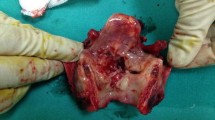Abstract
Advanced glottic cancer (T3,N+ & T4) is usually treated in the majority of centres by total laryngectomy. Carcinoma of the larynx is one of the very few subsets of all cancers which have shown a decrease in the 5 year survival rate and this phenomenon has been attributed to a Pharyngo-cutaneous fistula is the most common complication after total laryngectomy. Comparative study between double layered repair of pharyngeal mucosa against routine single layered repair in cases of “total laryngectomy with partial pharyngectomy”. All patients with the principal procedure of “total laryngectomy with partial pharyngectomy” in department of otorhinolaryngology and head-neck surgery, Netaji Subhash Chandra Bose Medical College, Jabalpur, Madhya Pradesh, India were included in this study. Out of the 20 patients who had undergone total laryngectomy irrespective of the type of mucosal repair, 5 (25 %) patients developed pharyngocutaneous fistula. Out of the 8 patients, with double layered mucosa repair, 1 (12.5 %) patient developed pharyngocutaneous fistula. Out of the 12 patients, with single layered mucosa repair, 4 (33 %) patients developed pharyngocutaneous fistula. Double layered repair of pharyngeal mucosa is associated with a lower incidence of pharyngocutaneous fistula formation and no increased incidence of dysphagia after complete radiotherapy as compared to single layered repair.

Similar content being viewed by others
References
Cavalot AL, Gervasio CF, Nazionale G, Albera R, Bussi M, Staffieri A et al (2000) Pharyngocutaneous fistula as a complication of total laryngectomy: review of the literature and analysis of case records. Otolaryngol Head Neck Surg 123(5):587–592
Galli J, De Corso E, Volante M, Almadori G, Paludetti G (2005) Postlaryngectomy pharyngocutaneous fistula: incidence, predisposing factors, and therapy. Otolaryngol Head Neck Surg 133(5):689–694
Parikh SR, Irish JC, Curran AJ, Gullane PJ, Brown DH, Rotstein LE (1998) Pharyngocutaneous fistulae in laryngectomy patients: the Toronto Hospital experience. J Otolaryngol 27(3):136–140
Tomkinson A, Shone GR, Dingle A, Roblin DG, Quine S (1996) Pharyngocutaneous fistula following total laryngectomy and post-operative vomiting. Clin Otolaryngol Allied Sci 21(4):369–370
Venegas MP, León X, Quer M, Matiño E, Montoro V, Burgués J (1997) Complications of total laryngectomy in relation to the previous radiotherapy. Acta Otorrinolaringol Esp 48(8):639–646
Markou KD, Vlachtsis KC, Nikolaou AC, Petridis DG, Kouloulas AI, Daniilidis IC (2004) Incidence and predisposing factors of pharyngocutaneous fistula formation after total laryngectomy. Is there a relationship with tumor recurrence? Eur Arch Otorhinolaryngol 261(2):61–67
Bresson K, Rasmussen H, Rasmussen PA (1974) Pharyngo-cutaneous fistulae in totally laryngectomized patients. J Laryngol Otol 88(9):835–842
Thawley SE (1981) Complications of combined radiation therapy and surgery for carcinoma of the larynx and inferior hypopharynx. Laryngoscope 91(5):677–700
Virtaniemi JA, Kumpulainen EJ, Hirvikoski PP, Johansson RT, Kosma VM (2001) The incidence and etiology of postlaryngectomy pharyngocutaneous fistulae. Head Neck 23(1):29–33
Weber RS, Berkey BA, Forastiere A et al (2003) Outcome of salvage total laryngectomy following organ preservation therapy: the radiation therapy oncology group trial 91–11. J Arch Otolaryngol Head Neck Surg 129:44
Sessions DG, Ogura JH, Fried MP (1975) Carcinoma of the subglottic area. Laryngoscope 85:1417
Thawley SE (1981) Complications of combined radiation therapy and surgery for carcinoma of the larynx and inferior hypopharynx. Laryngoscope 41:677
Grau C, Johansen LV, Hansen HS (2003) Salvage laryngectomy and pharyngocutaneous fistulae after primary radiotherapy for head and neck cancer: a national survey from DAHANCA. Head Neck 25:711
Virtaniemi JA et al (2001) The incidence and etiology of postlaryngectomy pharyngocutaneous fistulae. Head Neck 23:29
Ganly I, Patel S, Matsuo J et al (2005) Postoperative complications of salvage total laryngectomy. Cancer 15:2073–2078
Schwarts SR, Yueh B, Maynard C et al (2004) Predictors of wound complications after laryngectomy: a study of over 2000 patients. Otolaryngol Head Neck Surg 131:61–68
Mario A. Landera, Donna S. Lundy, Paula A. Sullivan: Dysphagia After Total Laryngectomy. Journals.asha 2010; 40–44
Author information
Authors and Affiliations
Corresponding author
Rights and permissions
About this article
Cite this article
Shukla, A., Dudeja, V. Comparative Study Between Double Layered Repair of Pharyngeal Mucosa Against Routine Single Layered Repair in Cases of “Total Laryngectomy with Partial Pharyngectomy” in Respect To Formation of Pharyngo-cutaneous Fistula. Indian J Otolaryngol Head Neck Surg 67 (Suppl 1), 8–11 (2015). https://doi.org/10.1007/s12070-014-0704-8
Received:
Accepted:
Published:
Issue Date:
DOI: https://doi.org/10.1007/s12070-014-0704-8




